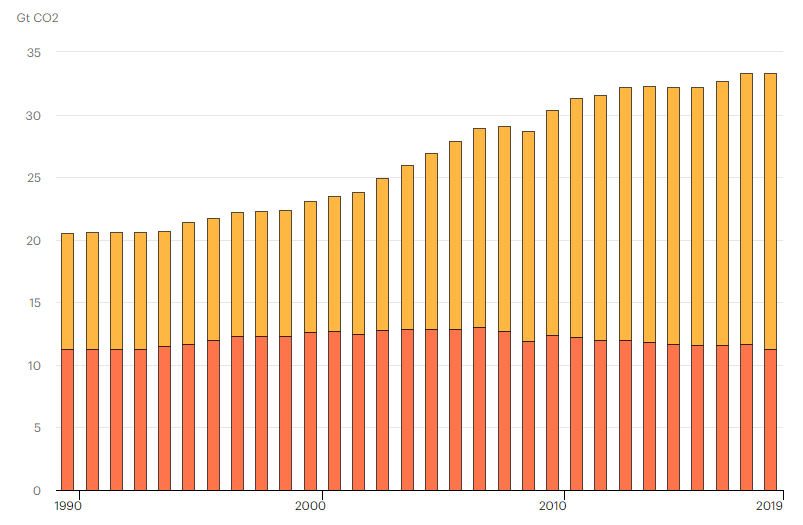According to the International Energy Agency (IEA), U.S. carbon dioxide emissions fell 2.9 percent (140 million metric tons) in 2019—the largest decline in energy-related carbon dioxide emissions of any country. The U.S. drop in emissions is mainly due to gas-fired generation replacing coal-fired generation as a result of lower natural gas prices. According to the Energy Information Administration, U.S. carbon dioxide emissions are now 14 percent (861 million metric tons) below their 2005 levels, which is the largest absolute decline by any country over that period. The United States is reducing carbon dioxide emissions despite having rejected the Paris Agreement, which President Trump announced he was withdrawing from in 2017.
Globally, IEA indicates energy-related carbon dioxide emissions flattened in 2019, following two years of increases. The flattening resulted primarily from a decline in carbon dioxide emissions from the power sector in advanced economies due to the addition of renewable (mainly wind and solar PV) capacity, fuel switching from coal to natural gas, and higher nuclear power output.
Global Energy-Related Carbon Dioxide Emissions, 1990-2019
Red—Advanced Economies
Orange—Rest of the World

U.S. Emissions
Nearly all of the decrease in carbon dioxide emissions in 2019 was due to fewer emissions from coal consumption—a decline of 14 percent in coal-related carbon dioxide emissions. Carbon dioxide emissions from natural gas increased by 3.2 percent and carbon dioxide emissions from petroleum declined by less than 1 percent.
The lower coal-fired emissions result from the electric power sector, which consumes 91 percent of the coal used in the United States. In 2019, electricity demand fell by 1.3 percent and coal-generated 16 percent less electricity, resulting in fewer coal carbon dioxide emissions. Coal’s share of electricity generation dropped to 23 percent in 2019 from 27 percent in 2018, while gas-fired generation increased its share to 38 percent—up from 35 percent in 2018. Although the electric power sector is using more natural gas, the increase in natural gas emissions in 2019 do not offset the decrease in coal emissions because natural gas-fired electricity generation is less carbon-intensive than coal-fired electricity generation.
According to the Energy Information Administration, the electric power sector installed nearly 23,000 megawatts of new generating capacity in 2019. The new capacity was primarily onshore wind (9,100 megawatts), natural gas (8,300 megawatts), and solar photovoltaic (5,300 megawatt) capacity. Wind and solar increased their combined share of generation to 9 percent in 2019 from 8 percent in 2018. Despite adding more capacity than natural gas, wind turbines and solar PV did not increase their generation share as much as natural gas because their capacity factors are much lower than that of natural gas—meaning that wind and solar power generate much less electricity per unit of capacity than natural gas combined cycle technology. Wind and solar are also intermittent technologies, meaning that they are not available 24/7 as the more traditional technologies are. They only work when nature allows, rather than working when there is a demand for their electricity.
Global Emissions
According to the IEA, global carbon dioxide emissions from coal use declined by almost 200 million metric tons, or 1.3 percent from 2018 levels, offsetting increases in emissions from oil and natural gas. Carbon dioxide emissions in advanced economies declined by over 370 million metric tons (3.2 percent), with the power sector responsible for 85 percent of the decline. Milder weather in many large economies resulted in reducing emissions by around 150 million metric tons from 2018 levels. Weaker global economic growth moderated the increase in carbon dioxide emissions in major emerging economies such as India.
Global carbon dioxide emissions from the power sector declined by about 170 million metric tons (1.2 percent) with the largest drops occurring in advanced economies where carbon dioxide emissions are now at levels not seen since the late 1980s (when electricity demand was one-third lower). The global power sector now accounts for 36 percent of energy-related carbon dioxide emissions across advanced economies, down from a high of 42 percent in 2012.
Generation from coal-fired plants in advanced economies declined by nearly 15 percent as a result of continued growth of renewables, coal-to-gas fuel switching, an increase in nuclear power and weaker electricity demand. The growth of renewables in electricity generation in advanced economies resulted in 130 million metric tons of carbon dioxide emissions savings in 2019. Wind accounted for the largest share of the increase, with output expanding 12 percent from 2018 levels. Solar PV saw the fastest growth amongst renewable sources, helping to push renewables’ share of total global electricity generation close to 28 percent. Coal-to-gas fuel switching for power generation avoided 100 million metric tons of carbon dioxide in advanced economies. Higher nuclear power generation in advanced economies, particularly in Japan and South Korea, avoided over 50 million metric tons of carbon dioxide.
Conclusion
Global energy-related carbon dioxide emissions flattened in 2019 as advanced economies reduced emissions enough to balance out increasing carbon dioxide emissions from developing economies. The United States led all countries in reducing carbon dioxide emissions in 2019 due to less coal-fired generation and lower electricity demand, with less carbon-intensive and lower-cost natural gas generation primarily replacing coal-fired generation. The United States leads by example, rather than by an international agreement that compels us to do so.



